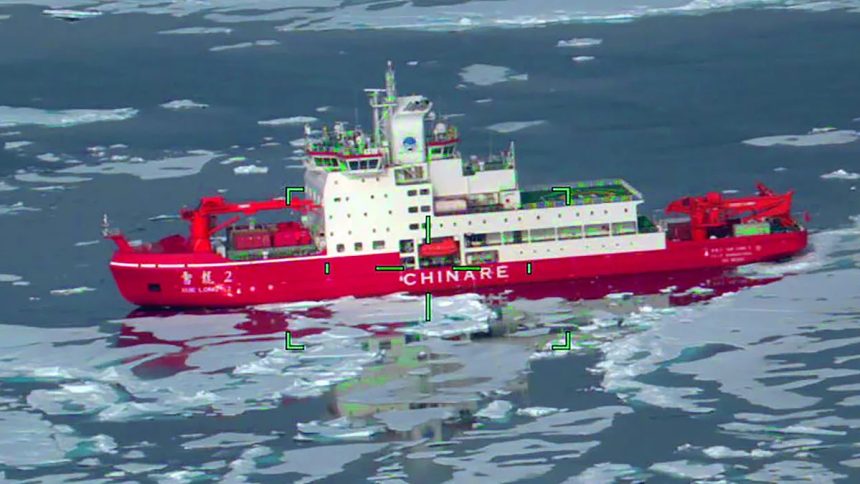The U.S. military and Coast Guard are monitoring the simultaneous appearance of five Chinese icebreaking vessels in the Arctic region near Alaska. That unprecedented presence represents two and a half times the number of icebreakers currently capable of being operated in the entire Arctic region by the U.S. Coast Guard. Another is scheduled to be commissioned on Sunday and plans are underway to build dozens more.
The Chinese icebreakers, which include a number of research-focused types, are being monitored by North American Aerospace Defense Command (NORAD) and U.S. Northern Command (NORTHCOM), a NORTHCOM spokesperson told The War Zone Thursday evening. The presence of so many Chinese icebreaking ships near Alaska was first reported by the G Captain maritime news website.
China now has five icebreakers in the Arctic (Google Earth)
“Although the vessels are operating in international waters and are not considered a Homeland Defense threat, their numbers represent an increase from years past,” the spokesperson said. “NORAD and USNORTHCOM will continue to monitor the ships’ progress while operating in the region.”
NORAD is responsible for the identification and warning of maritime tracks of interest and works closely with Canada and interagency partners to do so.
The Coast Guard “detected and responded to two Chinese research vessels operating in the U.S. Arctic and is currently monitoring a total of five similar vessels in or near the U.S Arctic,” the service announced Friday afternoon.
“On August 5, a C-130J Hercules fixed wing aircraft from Air Station Kodiak responded to the Chinese research vessels Ji Di and the Zhong Shan Da Xue Ji Di. Both vessels were transiting northeast in the Bering Sea,” the Coast Guard explained. “On August 6, the crew of U.S. Coast Guard Cutter Waesche (WMSL 751) again responded to the Zhong Shan Da Xue Ji Di as it was transiting north in the Chukchi Sea above the Arctic Circle, after passing through the Bering Strait.”
The C-130 and USCGC Waesche “were patrolling under Operation Frontier Sentinel, an operation that responds to adversaries operating in and around Alaskan and U.S. Arctic waters. The U.S. Coast Guard’s responses are intended to counter malign activities, defend sovereign interests, and promote maritime conduct consistent with international law and norms.”

The Zhong Shan Da Xue Ji Di, a Liberian Flagged Research Vessel, owned and operated by the Chinese University Sun Yat-Sen, as detected by a Coast Guard C-130 Hercules aircraft from Air Station Kodiak. (U.S. Coast Guard courtesy photo)
Late last month, the Coast Guard announced it sent an aircraft to observe another of those vessels.
The China-flagged research ship Xue Long 2 was spotted “on the U.S. Extended Continental Shelf (ECS) in the U.S. Arctic, approximately 290 NM north of Utqiagvik, Alaska,” the Coast Guard said in a release. “A Coast Guard C-130J Hercules fixed-wing aircraft from Air Station Kodiak responded to the Xue Long 2, an icebreaker operated by the Polar Research Institute of China and 130 NM inside the ECS boundary. The U.S. has exclusive rights to conserve and manage the living and non-living resources of its ECS.”
“The presence of these vessels is consistent with a three-year trend of increased activity from Chinese research vessels operating in the U.S. Arctic,” the Coast Guard noted. “Last year, three Chinese research vessels conducted research operations north of the Bering Strait.”

The Chinese icebreaker Xue Long 2 was spotted last month by the U.S. Coast Guard. (USCG)
These deployments come as melting ice coverage opens up new lanes of shipping up north, adding additional competition for influence on the water and the potential natural resources lying below the surface. As a result, the Arctic region is increasingly becoming a potential flashpoint, spurring a growing need for icebreakers. These vessels provide a presence where other ships can’t go and help pave the way so they can.
Though China is nearly 2,000 miles from the Arctic, it declared itself a near-Arctic nation in a 2018 whitepaper dubbing its interest in the region the “Polar Silk Road” economic initiative.
“For China, regular use of the Northern Route would be an economic boon,” noted the International Institute for Strategic Studies (IISS). “The distance from Shanghai to German ports is over 4,600km (about 2,900 miles) shorter via the Northern Route than via the Suez Canal.”
The Chinese Navy (PLAN) is increasing its activities in the Arctic as part of a broader strategy of expanding its influence.
TWZ has reported on myriad of PLAN operations in recent years that reflect this increased global ambition. U.S. Coast Guard vessels trailed four unidentified Chinese warships sailing in America’s Exclusive Economic Zone off Alaska’s Aleutian Islands in August 2021, and Chinese ships have had a sporadic but increasing presence there since.
The U.S. is lagging far behind both China and Russia in the number of icebreakers being operated up north.
Though Russia has dozens of icebreakers and China at least these five, the U.S. operates only two suitable for the Arctic – the Polar Star and the Healy. Of those, only the Polar Star is rated as a heavy icebreaker, displacing some 13,840 tons with a full load. However, only the Healy is currently operating in the Arctic, according to the Coast Guard.

The USCGC Healy helps free a Russian-flagged tanker from the ice near Alaska in 2012. USCG
A third icebreaker, the Storis, is scheduled to be commissioned into the Coast Guard Aug. 10, according to the Coast Guard. It was originally a vessel called the Aiviq, which the Coast Guard bought on the open market and modified.
“Immediately following the commissioning, Storis will depart on patrol in the Coast Guard Arctic District area of operations,” Lt. Cmdr. Steve Roth, a Coast Guard spokesman, told The War Zone on Friday. ”The U.S. Coast Guard operates the nation’s fleet of icebreakers to facilitate access to the polar regions to project U.S. sovereignty. CGC Storis was acquired to bolster these operations, providing near-term operational presence and supporting national strategic imperatives in the Arctic region as a bridging strategy for surface presence.”

STORIS
Though the Coast Guard operates 20 icebreakers in total right now, the vast majority can’t be operated in the polar regions.
The Coast Guard “currently operates an aging fleet of two polar icebreakers, 18 domestic icebreakers and 16 ice-capable buoy tenders and is pleased to add CGC Storis to the fleet,” Roth added. “The service must continue to replace, modernize and grow our fleet of icebreakers to safeguard our national security and economic prosperity that flows through America’s $5.4 trillion marine transportation system. We are working with the Administration and Congress to implement the President’s direction to acquire 40 icebreakers.”
“The 18 domestic icebreakers and 16 ice-capable buoy tenders are not capable of polar icebreaking in either the Arctic or Antarctic,” Roth noted.
Meanwhile, though China and Russia have heavily invested in icebreakers, the U.S. has not built a new one in about 50 years and efforts to add to the fleet have been plagued by delays. With that in mind, U.S. President Donald Trump has ordered a large buildup of America’s icebreaking fleet.
Trump’s massive tax and spending bill includes $4.3 billion for up to three new heavy Coast Guard Polar Security Cutters, $3.5 billion for medium Arctic Security Cutters, according to the Coast Guard.
In January, Trump told reporters he wanted 40 new icebreakers.
Construction of the first Polar Security Cutter (PSC) heavy icebreaker for the U.S. Coast Guard got underway late last year. The first of these new icebreakers was originally supposed to have been delivered this in 2024 and now may not arrive until 2029.
To help close the yawning icebreaker gap, the U.S., Canada and Finland created a resource-pooling plan last year to help meet a projected demand for as many as 90 of these vessels among allied nations over the next decade. The Icebreaker Collaboration Effort, or ICE Pact, seeks to significantly boost shipbuilding by its signatories. The three-pronged agreement calls for enhanced trilateral information exchange, collaboration on workforce development, and an invitation to allies and partners to purchase icebreakers built in American, Canadian, or Finnish shipyards.
Last month, four major shipbuilders from those three countries announced a partnership to build new icebreakers in the U.S.
The partnership of Bollinger Shipyards Rauma Shipyards Seaspan Shipyards and Aker Arctic (Aker) was created “to deliver the lowest-risk, fastest delivery solution of best-in-class Arctic Security Cutters (ASC) to the U.S. Coast Guard,” Seaspan said in a media release.
Though the bid submission deadline for the Arctic Security Cutter program has not been announced yet by the U.S. Coast Guard, “the Seaspan/Rauma/Bollinger/Aker consortium is fully prepared to begin construction immediately,” Dave Hargreaves, Seaspan Senior VP Strategy, Business Development and Communication, told The War Zone on Friday. “We will be able to leverage a mature design, fully operational production line, world-class facilities and deep experience in building technically complex vessels, to allow for delivery of the first vessel within 36 months of contract award.”

A conceptual image of a proposed Seaspan-Aker Multi-Purpose Icebreaker (MPI). (Seaspan)
The increased attention to the Arctic involves more than icebreakers. The region has seen significant investment in military resources, especially by Russia, which is massively expanding its aviation facilities at Nagurskoye Air Base, adjacent to its large Arctic Trefoil outpost.
Meanwhile, the U.S. is conducting its annual Arctic Edge (AE25) exercise to enhance readiness up north.
“This exercise will include NORAD and USNORTHCOM forces from Air Forces Northern, Army North, Naval Forces Northern, Marine Forces Northern, Special Operations Forces North, Alaska NORAD Region, Alaska Command, and the Continental U.S. NORAD Region,” according to NORAD. “AE25 also includes participation from UK, Denmark, and interagency partners including the Alaska National Guard, FBI, U.S. Coast Guard, NOAA, Alaska State and local law enforcement, and Alaska Native communities.”
However, any activities conducted during AE25 will have to rely on the Coast Guard’s limited icebreaking resources if needed. Though the Trump administration is pushing to build dozens of additional icebreakers capable of plying the Arctic, the fact that China now has five there highlights how far the U.S. has to go to catch up.
Contact the author: howard@thewarzone.com









